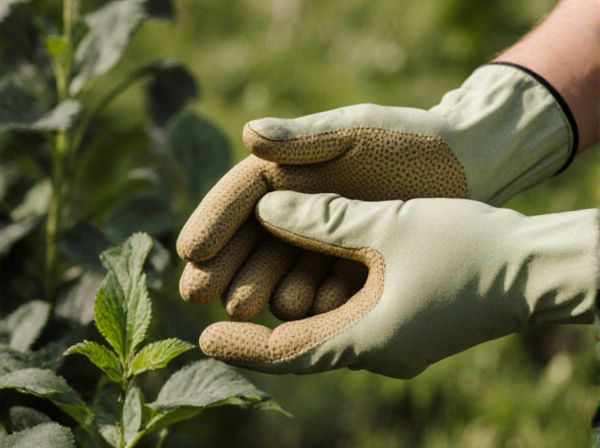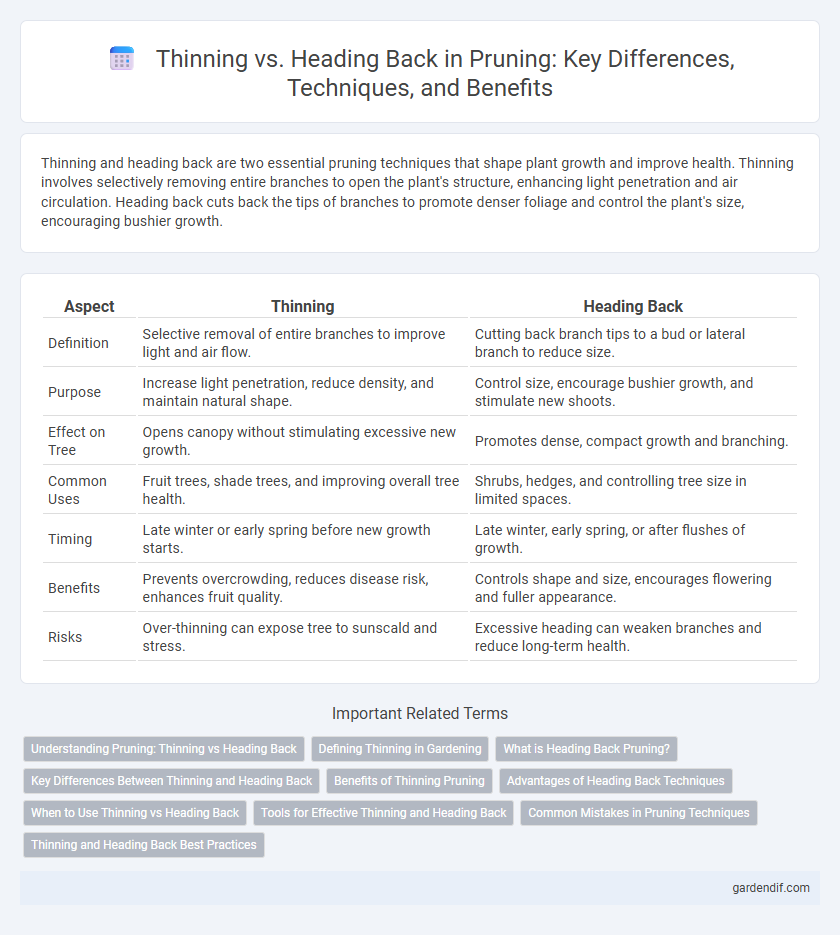
Thinning vs Heading Back Illustration
Thinning and heading back are two essential pruning techniques that shape plant growth and improve health. Thinning involves selectively removing entire branches to open the plant's structure, enhancing light penetration and air circulation. Heading back cuts back the tips of branches to promote denser foliage and control the plant's size, encouraging bushier growth.
Table of Comparison
| Aspect | Thinning | Heading Back |
|---|---|---|
| Definition | Selective removal of entire branches to improve light and air flow. | Cutting back branch tips to a bud or lateral branch to reduce size. |
| Purpose | Increase light penetration, reduce density, and maintain natural shape. | Control size, encourage bushier growth, and stimulate new shoots. |
| Effect on Tree | Opens canopy without stimulating excessive new growth. | Promotes dense, compact growth and branching. |
| Common Uses | Fruit trees, shade trees, and improving overall tree health. | Shrubs, hedges, and controlling tree size in limited spaces. |
| Timing | Late winter or early spring before new growth starts. | Late winter, early spring, or after flushes of growth. |
| Benefits | Prevents overcrowding, reduces disease risk, enhances fruit quality. | Controls shape and size, encourages flowering and fuller appearance. |
| Risks | Over-thinning can expose tree to sunscald and stress. | Excessive heading can weaken branches and reduce long-term health. |
Understanding Pruning: Thinning vs Heading Back
Thinning pruning involves selectively removing entire branches or shoots to improve light penetration and air circulation, promoting healthier growth without drastically altering the plant's shape. Heading back focuses on cutting back branch tips to encourage denser foliage and stimulate bushier growth, often used to maintain size or shape. Understanding these techniques helps gardeners apply the appropriate method based on the desired plant structure and growth response.
Defining Thinning in Gardening
Thinning in gardening involves selectively removing entire branches or stems to improve air circulation, light penetration, and overall plant health. It helps reduce overcrowding and directs energy towards the growth of remaining branches or fruits, promoting a stronger structure. This technique contrasts with heading back, which cuts branches partially to encourage bushier growth rather than removing them completely.
What is Heading Back Pruning?
Heading back pruning involves cutting a branch or stem back to a bud or lateral branch to encourage dense growth and shape the plant. This technique promotes bushier development by stimulating new shoots closer to the cut site, improving plant structure and overall health. It contrasts with thinning, which removes entire branches to improve light penetration and air circulation.
Key Differences Between Thinning and Heading Back
Thinning pruning involves selectively removing entire branches or stems at their origin to improve air circulation and light penetration, promoting overall plant health and growth. Heading back cuts are made by trimming branch tips, stimulating bushier growth and controlling plant size without removing major structural elements. The key difference lies in thinning targeting branch removal for openness and heading back focusing on tip cutting to encourage denser foliage.
Benefits of Thinning Pruning
Thinning pruning enhances air circulation and light penetration within the tree canopy, promoting healthier growth and reducing disease risk. By selectively removing entire branches, thinning maintains the natural shape and structural integrity of the tree, enabling stronger branch development. This method also improves fruit quality and overall tree productivity by allocating resources more efficiently.
Advantages of Heading Back Techniques
Heading back techniques in pruning stimulate vigorous new growth by cutting branches back to a bud or lateral branch, promoting a fuller, denser structure. This method allows for better control over tree shape and size while encouraging the development of strong scaffold branches, enhancing overall plant health. Heading back also helps to rejuvenate older plants by stimulating fresh shoots and increasing fruiting potential in many species.
When to Use Thinning vs Heading Back
Thinning is ideal for improving air circulation and light penetration by selectively removing entire branches, best used on trees and shrubs that have dense growth. Heading back is preferable when controlling size and promoting bushier growth by cutting back branch tips, often applied to young plants or hedges needing shape refinement. Choose thinning to maintain natural structure and heading back to encourage fuller, more compact growth.
Tools for Effective Thinning and Heading Back
Effective thinning and heading back require specialized pruning tools such as bypass shears for clean cuts that minimize plant damage. Loppers with long handles enable precise thinning by removing larger branches deep within the canopy, promoting airflow and light penetration. For heading back, sharp pruning saws and hand pruners ensure controlled cut sizes that stimulate healthy regrowth and maintain plant structure.
Common Mistakes in Pruning Techniques
Thinning and heading back are essential pruning techniques, yet common mistakes include applying heading back too aggressively, which can lead to dense, weak branches prone to disease. Over-thinning may cause excessive sunlight penetration, damaging foliage and reducing the plant's natural shape. Proper balance between removing selective branches (thinning) and cutting back tips (heading back) ensures healthy growth and structural integrity.
Thinning and Heading Back Best Practices
Thinning involves selectively removing entire branches to improve light penetration and air circulation, which reduces disease risk and promotes healthy growth. Heading back cuts branches or stems back to a bud or lateral branch, encouraging denser growth and shaping the plant's form. Best practices for thinning include targeting crowded or crossing branches, while heading back should focus on maintaining the plant's natural shape and preventing overgrowth.
Thinning vs Heading Back Infographic

 gardendif.com
gardendif.com